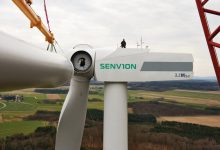Long held plans to build a 630MW wind farm on South Australia’s Yorke Peninsula, and help power Adelaide via an undersea cable, have taken a major step forward after a revised development application was given the green light.
Wind energy giant Senvion said on Tuesday that the $1.6 billion project would use fewer – but larger and more efficient – turbines, after the state government approved a variation to the Development Approval.
It said the total number of turbines had been reduced from 187 to a maximum of 170, using the latest wind turbine technology, with an increased maximum tip height of up to 220 metres, and an increased rotor diameter of up to 160 metres.
 The ambitious project also includes plans for a high voltage undersea cable, coupled with a synchronous condenser and flywheel, which Senvion says will contribute to increased network security and reliability for the South Australia grid.
The ambitious project also includes plans for a high voltage undersea cable, coupled with a synchronous condenser and flywheel, which Senvion says will contribute to increased network security and reliability for the South Australia grid.
“The Ceres Project wind farm is one of the largest renewable energy projects in Australia and the first to connect a capital city to wind power via an undersea cable,” the project website says.
“With no overhead power lines, the Ceres Project will bring clean power to 225,000 homes via a High Voltage Direct Current (HVDC) connection under the Gulf of St Vincent directly into Adelaide’s power grid.
It’s the second revision to the project, following an earlier amendment in September of 2017 that increased the length of each turbine blade from 57 metres to 70 metres, thus reducing the number of turbines required from the originally planned 197, to 187, at a height of 93m.
That change, which was approved by the then Labor state government, stated that the project – which has been in the planning since 2011 – must be completed by August 10, 2021.
The statement from Senvion said input from the community had helped shape the Ceres Project, with agreements to establish a $150,000 a year community fund and $50,000 a year community fire fighting fund.
Agreements have apparently also been made with local farmers to stop turbines as needed, to support aerial spraying activities.
Senvion notes there will also be more than 135km of underground cables to avoid the use of overhead powerlines; setbacks of at least 2 km from coastal settlements and of 1.3 km from neighbouring households – exceeding government requirements.
Direct local benefits have been estimated at $8 million per annum for the 25-year life of the wind farm.
All that noted, the massive project is not quite over the line yet. Senvion still has to meet “a number of conditions” around construction and operation and associated infrastructure – including transformers, underground transmission lines and cabling – before it can make a start on construction.










